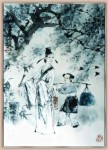The Butterfly Lovers – Violin Concerto
If you want to listen the music online, it will take your about one  minute to begin. We are sorry, we have no enough time to optimize the speed.
minute to begin. We are sorry, we have no enough time to optimize the speed.
[audio:butterflylovers.mp3]
The music of Liang Zhu, or “Butterfly Lovers,” is undoubtedly the best-known and most popular in all of China. It is also one of the few Chinese pieces that have often appeared on the international stage. Almost everyone in China can hum a few lines of the violin concerto, which can be traced to a Chinese folk legend “Liang Shanbo and Zhu Yingtai”.
According to the legend, Zhu Yingtai assumes a male identity so she may travel to study in Hangzhou, a southern city in China, where she meets Liang Shanbo. In the course of their studies, Zhu and Liang become very close friends. From a Confucian perspective, the notion of “Junzi” (gentleman) is a well-exemplified ideal in Chinese history and its quality and characteristics are well expounded upon by Confucian scholars. Basically, this implies the highest integrity, morality and demeanor, coupled with well-refined abilities and skills both in martial arts and academia — the kind of relationship that Zhu and Liang had achieved. When the time came for Zhu to return home, the pair is overcome with much suppressed sadness. Zhu offers her younger sister’s hand in marriage and entreats Liang to visit her residence to discuss the issue with her parents. Liang is unaware that Zhu is female nor that she does not have a younger sister. (She is, in fact, offering her own hand in marriage.)
A year passes before Liang makes his way to Zhu’s residence. He is overjoyed to realize Zhu’s true identity and that she is in love with him. However, happiness turns into sorrow as the two soon discover that Zhu has been betrothed to another man. In great sadness, the two lovers meet at the tower and lament their great misfortune. Upon his return to Hangzhou, Liang falls ill in his great misery and dies. When Zhu hears of this on her wedding day, she flees to his grave. There, legend has it that her tears move the heavens so much that the clouds themselves shed tears over Zhu’s grief. Then, the earth beneath her cracks open and the ill-fated Zhu commits suicide by jumping into the open grave. Miraculously, the pair is transformed into butterflies. Arising into the sky, they flutter and dance side by side among the flowers, never to be separated again.
Butterfly Lovers was composed in 1958 by Chen Gang and He Zhanhao who were studying at the Shanghai Conservatory of Music. The pair was exploring the feasibility of setting Chinese music to a (Western) symphonic medium, incorporating borrowed devices from Chinese folk theatrical music as well as vocal techniques of Zhejiang’s Yu Theatre. The end result was a free-form concerto for the violin in one movement. Remaining true to the legend, the concerto may be divided into three sections as follows:
Part I: describes Liang and Zhu’s meeting (Liang is represented by the cello and Zhu, the violin), their joining hands in brotherhood, the blossoming of their love; their study and sad separation when Zhu goes home.
Part II: portrays their resistance to the arranged marriage, their meeting at the tower, and the eventual deaths of the lovers. The violin’s free rhapsodic sounds incorporate many syncopated chords (Zhu and her resistance to marriage) pitted against the orchestra (Zhu’s father forcing the marriage) into a dramatic play. The meeting at the tower is exemplified by the interplay between the cello solo (Liang) and the violin solo (Zhu). The ensuing section employs borrowed theatrical devices to bring across the Liang’s illness and death and further drama in Zhu’s suicide (Chinese gong and reprise).
Part III: wraps up the saga as the flute and harps spark the mystery of the imminent metamorphosis. The play of the butterflies is heard following a recapitulation of the love theme and mortals echoing their happiness.